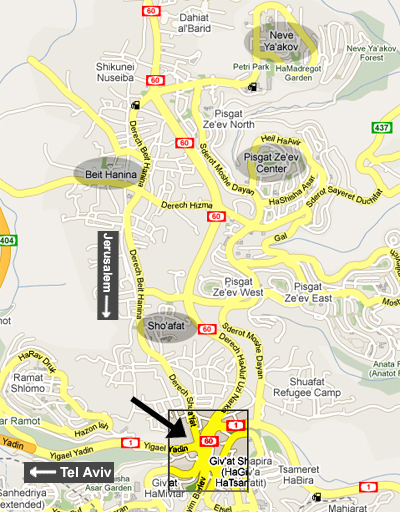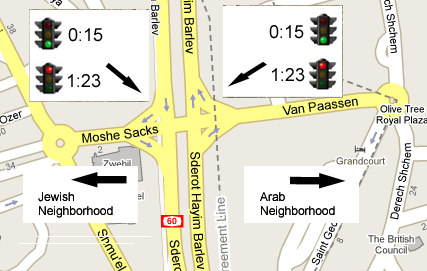The Economist, with Al Jazeera hot on its heels, has dug up a new Israeli villain: traffic lights.
This joins aphrodisiac bubble gum, poisonous candy, super rats, and stripper assassins in Israel's purported arsenal of tools to oppress Arabs.
According to a March 6, 2010 article
in the mainstream British news magazine, traffic lights in Jerusalem
"flick green only briefly for cars from Palestinian districts while
staying green for cars from Jewish settlements for minutes."
When pressed by CAMERA to provide evidence for this wild charge, the Economist
provided a list of intersections at which drivers from Arab
neighborhoods are allegedly forced to wait at long red lights to make
way for those from Jewish neighborhoods. Shortly afterward —
coincidentally, or not — Al Jazeera English broadcast a short news segment purportedly demonstrating the discrimination at one of the intersections named by the Economist.
A CAMERA field investigation reveals that the Economist and
Al Jazeera claims are absurdly false — the latest examples of how even
the most benign irritations encountered in quotidian life are
manipulated to demonize the Jewish state. In fact, the discrepancy
between the timing of red and green lights is related, as in cities
across the world, to street size and traffic flow, affecting cars from
both Arab and Jewish neighborhoods equally.
Beit Hanina Junction
The Economist's first example was an
intersection in northern Jerusalem near the Arab neighborhoods of
Shuafat and Beit Hanina and the predominantly Jewish neighborhoods of
Neve Yaakov and Pisgat Zeev. This same area was the subject of the Al
Jazeera feature.
According to the Economist, traffic lights for
cars approaching Jerusalem from the Arab areas remained green for 18
seconds, while traffic from the Jewish neighborhoods toward Tel Aviv
enjoy the benefit of a one-minute-and-30-second green light.
This comparison is highly disingenuous, as it does not compare apples to apples.
 The image to the right shows the neighborhoods mentioned by the Economist. The intersection best matching the magazine's description is shown in the highlighted square.
The image to the right shows the neighborhoods mentioned by the Economist. The intersection best matching the magazine's description is shown in the highlighted square.
The road from Pisgat Zeev and Neve Yaakov to Tel Aviv
is Route 1, a major thoroughfare that crosses Israel. Traffic on this
busy highway naturally has priority at junctions with smaller roads such
as Derech Shua'fat, which comes south to Route 1 from the Arab
neighborhoods of Shuafat and Beit Hanina.
A more apt equivalent to Derech Shua'fat at this
intersection is Rechov Sheshet Hayamim, the road leading north to Route 1
from the Jewish neighborhoods of Givat Hamivtar and Ramat Eshkol. At
this intersection, travelers encounter similar wait times to those on
Derech Shuafat — a green light for 16 seconds and a red light for one
minute and 41 seconds.
Another comparable intersection can be found less
than two kilometers to the west, at the junction of the road from the
Jewish neighborhood of Ramat Shlomo and Route 1. Here, motorists
encounter a much shorter green light then do those at the Derech Shuafat
intersection.
Clearly, then, the discrepancy between red- and
green-light times at the intersection is a function of road size and not
ethnicity. Traffic on larger roads have priority over smaller roads
that intersect it, whether those roads are from the Arab neighborhoods
or Jewish neighborhoods.
Of course, the major arteries into downtown Jerusalem
are open to all travelers. Motorists from the Arab neighborhoods are
certainly able to use any of the larger roads crossing Route 1. For
example, it is a mere half kilometer detour for Beit Hanina residents
opting to skip the allegedly-racist traffic light by using the overpass
highway crossing Route 1 (Route 60/Derech Ha'aluf Uzi Narkis).
Wadi Joz Junction
The same applies for the other intersections cited by the Economist as evidence that Jerusalem traffic lights discriminate.
The magazine claims that cars exiting the Arab
neighborhood of Wadi Joz to the main highway into downtown Jerusalem
encounter a green light for 17 seconds and a red light for one minute
and 30 seconds. They compare this to a one-minute-20-second green light
for travelers from Ma'aleh Adumim.
Again, the Wadi Joz junction is an intersection
between a smaller road and a large east-west thoroughfare. It is to be
expected, then, that the larger road from Ma'aleh Adumim, which serves a
community with three times the population as Wadi Joz, has longer green
lights.
The more analogous comparison to the traffic from
Wadi Joz is the traffic on the road reaching the same intersection from
Hebrew University's Mount Scopus campus on the opposite side. The
motorists on that road — mostly Jews — fare worse than those from Wadi
Joz. They encounter a green light for only eight seconds and a red light
for two minutes and 12 seconds.
Abu Tor Junction
The Economist also claims that for cars
exiting the Arab part of Abu Tor, the lights remain green for five
seconds and red for one minute and 20 seconds.
What they don't mention is that the Jewish population
of Abu Tor uses the very same roads to exit the neighborhood. When
these roads meet Derech Hebron/Route 60, one of the busiest roads in the
city, both Jews and Arabs encounter the same red lights.
Indeed, every street that connects to Derech Hebron
has a very short green light. From northern Abu Tor, lights are green
for 8 seconds and red for one minute 32 seconds. From southern Abu Tor,
they are green for 8 seconds and red for one minute 10 seconds. From the
Jewish neighborhood of East Talpiot, they are green for 9 seconds and
red for one minute 30 seconds. And from the Jewish neighborhoods of
Arnona and Ramat Rachel, they are green for 7 seconds and red for one
minute 16 seconds.
Arab Business District
The same Route 60 causes the delay for cars exiting
eastern Jerusalem's Arab commercial district toward western Jerusalem,
which the Economist cites as further proof of anti-Arab
discrimination. As mentioned above, this major road — one, by the way,
heavily trafficked by Arab cars — takes precedence over smaller roads.
 Further
demonstration of this non-discriminatory traffic pattern is seen at a
nearby intersection on Route 60. Cars approach the intersection on one
side from the Jewish neighborhoods of Mea She'arim (Moshe Sacks St.)
and on the other side from the predominantly Arab neighborhood of Sheikh
Jarrah (Van Paassen St). Both encounter a 15-second green light and a
one-minute-23-second red light.
Further
demonstration of this non-discriminatory traffic pattern is seen at a
nearby intersection on Route 60. Cars approach the intersection on one
side from the Jewish neighborhoods of Mea She'arim (Moshe Sacks St.)
and on the other side from the predominantly Arab neighborhood of Sheikh
Jarrah (Van Paassen St). Both encounter a 15-second green light and a
one-minute-23-second red light.
Clearly, the Economist's allegation that Arabs
are impeded because "traffic lights flick green only briefly for cars
from Palestinian districts while staying green for cars from Jewish
settlements for minutes" is specious.
We provided Economist editors with this documentation. It remains to be seen whether they will correct their slanderous misrepresentation.
Al Jazeera
Unsurprisingly, Al Jazeera bombarded viewers with additional outrageous fabrications. Reporter Jacky Rowland alleged:
The settlers journey to work will soon be even easier, because the municipality is building a tramway for them. The rail lines have robbed the Palestinians of two lanes of traffic.
The absurdity and hypocrisy of this charge is
dumbfounding. The tramway is not being built for "settlers," but for all
Jerusalem's residents, both Jewish and Arab. In fact, there will be
numerous stations serving Arab neighborhoods. This is precisely why it
"robs" Palestinians of traffic lanes — just as it robs Jews of traffic
lanes where the rail is being built in Jewish neighborhoods.
No comments:
Post a Comment